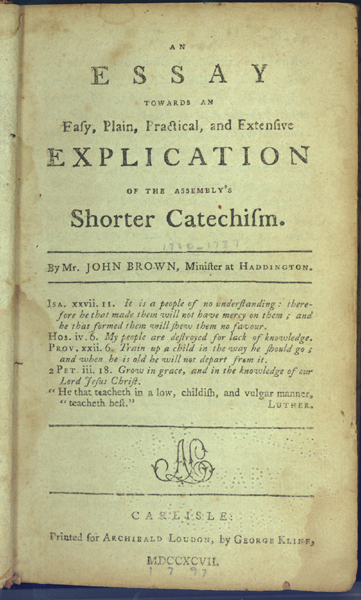The Walker Library

Elkanah (1805-1877) and Mary Richardson (1811-1897) Walker were one of six missionary couples (plus one single man) sent by the American Board of Commissioners for Foreign Missions to the Oregon Mission. The Walkers and one other couple, Cushing and Myra Eells, established the mission at Tshimakain, near the present day town of Ford, Washington, to work with the Spokane Indians.
Born at North Yarmouth, Maine, in 1805, Elkanah Walker received formal education at Kimball Union Academy (Meriden, N.H.) and Bangor Theological Seminary. While a student at Bangor Theological Seminary, the American Board accepted him for missionary service. Elkanah met and became engaged to Mary Richardson, a woman who was recently rejected by the American Board for missionary service because she was single. Mary had previously received her education at Maine Wesleyan Seminary in Kent’s Hill, Maine. Her education was anything but formal, however; she was permitted to take classes, but did not receive a diploma because she was a woman. Elkanah spent most of their ten-month engagement completing his studies at Bangor Theological Seminary. They were married in March, 1838. Elkanah and Mary, both having dedicated their lives to missionary service, were quickly appointed, not to South Africa, as originally planned, but to the Oregon Mission by the American Board of Commissioners. In less than a month after their wedding, the Walkers were on their way to the Oregon territories
The Walkers were joined on their journey by three other couples-Rev. and Mrs. Cushing Eells; Rev. and Mrs. Asa B. Smith; and Mr. and Mrs. William H. Gray-all appointees of the American Board-to the already established mission at Waiilatpu, near present-day Walla Walla, Washington. Rev. Marcus and Narcissa Whitman and Rev. Henry and Eliza Spalding had established the mission there. A single man-Andrew Rodgers-joined the party en route and accompanied them. The Walkers and the Eells established the mission at Tshimakain the following year (1838).
Both of the Walkers, but particularly Mary Richardson Walker, wrote extensively in their diaries. These diaries provide great detail into the physical, psychological and spiritual endeavors of missionary service in the primitive days of the Pacific Northwest. Much about the Walkers and the activities of the Oregon Mission have been researched and reported by Clifford M. Drury, through his books, articles and research papers.
The American Board closed Tshimakain after nine years (1838-1848), along with the entire Oregon Mission, as a result of the Whitman Massacre.
The Walkers eventually settled near Forest Grove, Oregon. Elkanah pastored a church, did itinerant preaching, and was also instrumental in starting the Tualatin Academy in Forest Grove, which later became Pacific University. The Walkers had seven children, six boys and a daughter. Their first child, Cyrus, was the first surviving male white child born west of the Rockies and four other Walker children were born at Tshimakain. Elkanah died in 1877, ending a life that often suffered from a weak disposition. Mary died in 1897 in Forest Grove, having survived her husband by twenty years. She was the last surviving member of the original thirteen members of the Old Oregon Mission.
The impact of the Walkers and the other members of the Oregon Mission was significant, but not immediate. Although they could not count a single convert from the work at Tshimakain, an active congregation was later established among the Spokane Indians. Elkanah wrote a primer in the Spokane Indian language, “Etshiit thlu Sitskai thlu Siais thlu Sitskaisitlinish”, which was printed in 1842 on the Lapwai Mission press (Washington State University MASC holds a facsimile copy). In addition, the establishment of the Old Oregon Mission sites provided an example to the nation that settlement of the Oregon Territories was not only possible, but also feasible.
“The Record” (Pullman, Wash., Friends of the Library, Washington State University), states that the Walker library “is believed to have been the first collection of books in the present Inland Empire.” If not the first, the Walker library was surely one of the first two or three book collections to enter the Pacific Northwest, according to historian Clifford M. Drury. For Drury’s summary of the Walker library, see his article in the Oregon Historical Quarterly, Vol. 42 (1941), pp. 169-171.
There are 175 titles in the Walker library; several of these titles have more than one volume (e.g. has 19 volumes). Provenance (evidence of former owners such as autographs and other annotations) provides a natural division of the Walker library into five parts: the books of Elkanah Walker (40); the books of Mary Richardson Walker (10); the books of the Walker family (approximately 115); the 7 books from the Columbia Mission library (originally located at the Spalding mission at Lapwai) and three books owned by Andrew Rodgers.
The Books of Elkanah Walker
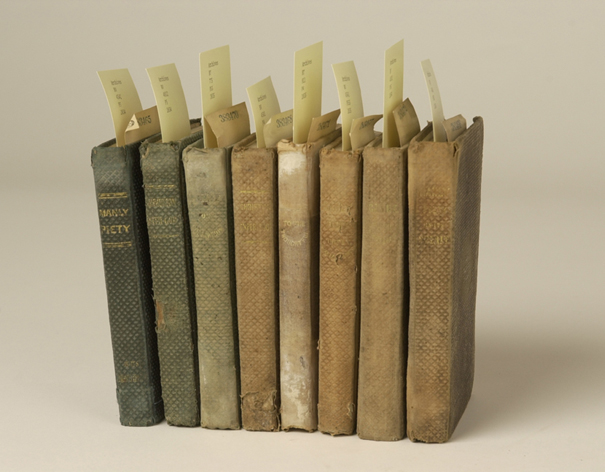
Several of the books were used by Elkanah Walker while he was a student at Bangor Theological Seminary. Some are inscribed as personal gifts from friends. One example: on April 1, 1839, Walker wrote the American Board, requesting that they send his copy of Rosemulleri”s Compendium on the Old Testament in Latin.Clifford Drury writes that Walker had recently met Fathers Demers and Blanchet, and that he explained to the American Board that “Since the Priests have come, I have already found use for my little knowledge of Hebrew.” Each of the four volumes is inscribed “E. Walker from his aff. friend & fellow servant in the cause of Missions, C. Hamlin” to Walker from his friend Cyrus Hamlin, founder of Roberts College in Constantinople, Turkey.
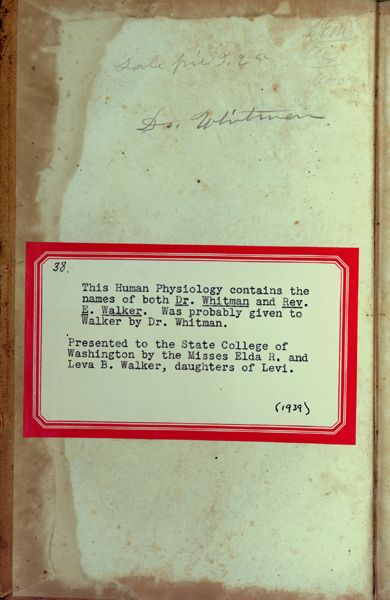
Two of the books are signed, “Dr. Whitman” and include a label noting that the books, “were probably given to Walker by Dr. Whitman.” Other associated names to Elkanah’s books include B.E. Lippincott, Louis Turner, A. Briggs, George H. Durham and P.N. Nystrom.
Specific genre of Elkanah Walker’s books include an eight volume set of devotional works, books used in translation work, works written in Latin Greek or Hebrew, and books having something to do with medicine and healing.
The Books of Mary Richardson Walker
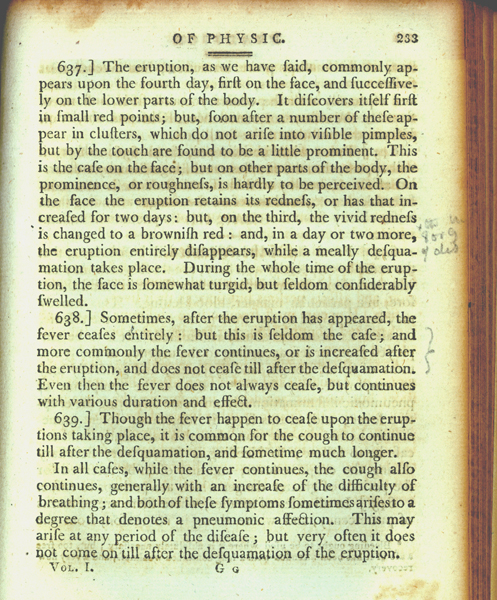
The book, Memoir of Sir Benajmin Thompson, Count Rumford includes a presentation inscription from Cyrus Woodman, and the donor’s note “There is some biographical connection between Rumford and the Walkers.”
The book, Palms of Elim is inscribed as a gift to Mary from S. A. M. Bosworth. Mary Walker herself writes two inscriptions in Harp of the Willows, one identifying the book’s author, Mrs. Elvira Perkins, as a missionary stationed at The Dalles, Oregon and a second inscription identifying her as a former acquaintance when they were both students at Maine Wesleyan Seminary. Mary mentions writing notes to a Mrs. Perkins in her diaries.
Mary also writes in her diary about “covering books with deer skins.” A book which Mary simply calls the “encyclopedia” in her diaries, still has a portion of the deerskin attached. The “enclyclopedia”, identified as Fessenden’s Encyclopedia of Religious Knowledge is referred to in other places in her diaries, as for example, when she writes, “…To divert them [Cyrus, her son, and Sarah Goudy] I gave them the Encyclopedia to look at the pictures. While they were looking, something troubled the hens and Sarah ran to see what it was. Cyrus ran too but not without first placing the big [book] on the table. He discovers every day a disposition to put things in their proper place.”
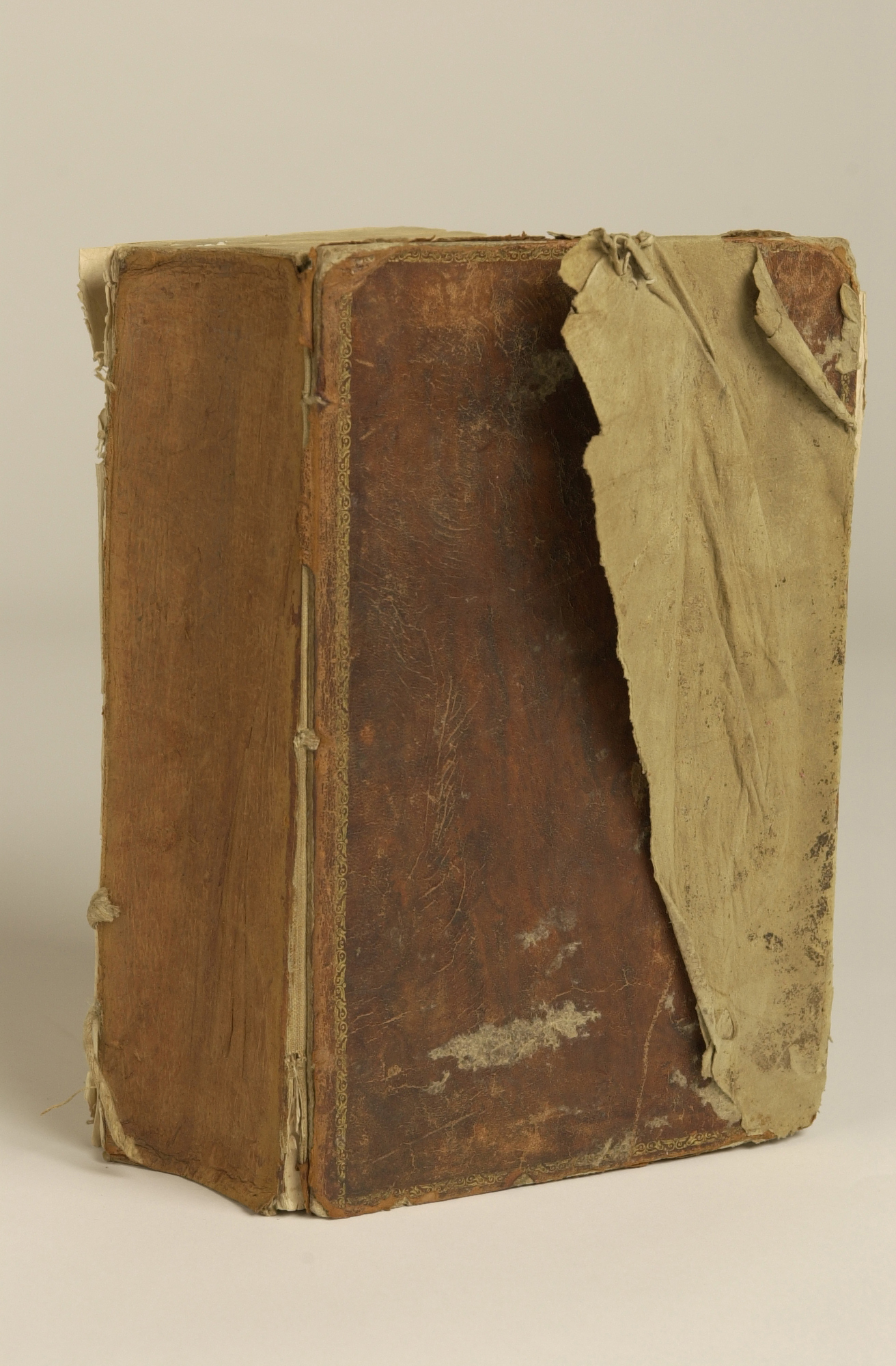
Books of Andrew Rodgers
Three books are inscribed Andrew Rodger’s book. All are dated Oct. 8, 1847, which was little more than a month before the Whitman Massacre (November 29, 1847) of which Rodgers was a victim.
Books of the remainder of The Walker Family
The Walker family books comprise the largest segment of the collection. Many of these are signed or inscribed to Levi C. Walker, the next to last child of Elkanah and Mary or to Samuel Thompson Walker, their youngest. Elda R. and Leva B. Walker, Levi’s daughters, were the actual donors of the Walker Library to what was then the State College of Washington (1939).
Both women were professors of botany at the University of Nebraska when the books were donated, perhaps reflecting their grandmother’s love of science.
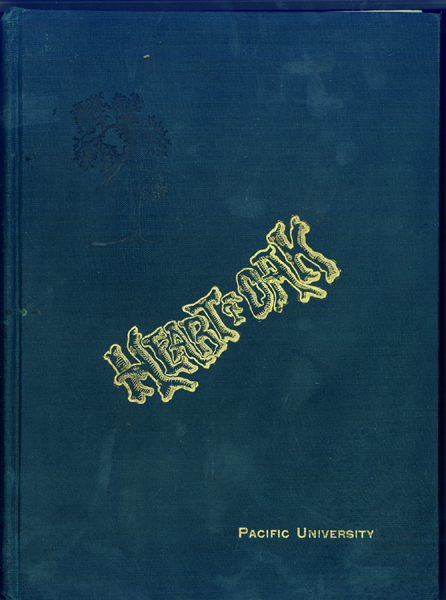
The collection includes the 1901 Heart of Oak, the school annual for Pacific University. The names of several members of the Walker family, including the donors, Elda and Leva Walker, and J. Elkanah Walker, missionary to Foochow, China, are included. He was the only child of Elkanah and Mary Richardson Walker to serve in the Christian ministry.
Books of The Columbia Mission Library
The Walker library includes seven books from the Columbia Mission Library. The Columbia Mission Library was located in Lapwai, Idaho. Henry Spalding was the appointed librarian. Two books from this group are mentioned in Mary Walker’s diary; they must have been brought to Tshimakain from the Nez Perce Mission at Lapwai (Idaho) by the Walkers from a visit to the Spalding Mission there.
Genre/Subject Access
The Walker Library contains numerous kinds of books that may be described as: textbooks (mostly math and science, in addition to the readers and spellers), hymns and music, Bibles and aids to Bible study, dictionaries and grammars, biography, poetry, and novels and other fiction.
Subject arrangement, of course, overlaps. Representative subject matter includes, but is not limited to: history; mathematics and algebra; physics and astronomy; psychology & ethics; and medicine, physiology & diseases.
General Condition of the Books
Some of the books are in poor condition, lacking covers, title pages and a few have pages missing, as is noted on the catalog record. Nearly all show indications of heavy use. In spite of this heavy use, some are in surprisingly good condition. A good example of this is volume 2 of the Bible of Noah Emerson, Mary Walker’s pastor in Maine. Pastor Emerson conducted the Walker’s wedding. The Bible contains the notes of a complete sermon, the catechism adopted by the church in East Baldwin, Maine, and extensive notes in the margins. The Bible lacks a title page, but is in otherwise good condition.
The oldest book in the Walker library is An Essay Towards an Easy, Plain, Practical, and Extensive Explication of the Assembly’s Shorter Catechism by John Brown, published in 1797 and is inscribed, “John Reads’ Book”.
Bibliography
Book Reviews
- G. Thomas, review of “The Mountains We Have Crossed: Diaries and Letters of the Oregon Mission 1838” ed. by Clifford Merrill Drury, with an Introduction by Bonnie Sue Lewis and “On Sidesaddles to Heaven: The Women of the Rocky Mountain Mission by Laurie Winn Carlson. in Oregon Historical Quarterly (Spring 2000) Vol. 101 #1: pp. 118-120.
- Larry Waldron, review of “Nine Years Among the Spokane Indians” in American West Vol. 14 #1 (Jan-Feb. 1977): p. 58.
Articles
- Clifford M. Drury. “Wilderness Diaries: A Missionary Couple in the Pacific Northwest 1839-1848,” American West 13 No. 6 (November-December 1976): 4-9, 62-63.
- Joyce W. Prairie, “Mary Richardson Walker: Missionary, Wife, Mother, ” Columbia: The Magazine of Northwest History 11 #1 (Spring 1997): 26-31.
- James W. Montgomery, “Mating Practices of Early Protestant Missionaries,” The Pacific Northwesterner 27 #1 (Winter, 1983): 65-71.
- Clifford M. Drury, “The Spokane Indian Mission at Tshimakain, 1838-1848” Pacific Northwest Quarterly, 67 #1 (Jan. 1976): 1-9.
Books
- Clifford M. Drury. Nine Years With the Spokane Indians: The Diary, 1838-1848, of Elkanah Walker. Glendale, California: The Arthur H. Clark Company, 1976.
- Clifford Merrill Drury. Henry Harmon Spalding. Caldwell, Idaho: The Caxton Printers, Ltd., 1936.
- Clifford Merrill Drury: First White Women over the Rockies: Diaries, Letters, and Biographical Sketches of the Six Women of the Oregon Mission Who Made the Overland Journey in 1836 and 1838, Volume Two. Glendale, California: The Arthur H. Clark Company, 1963.
